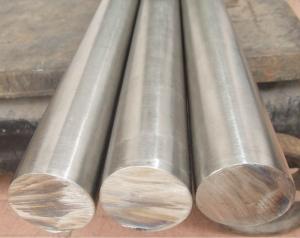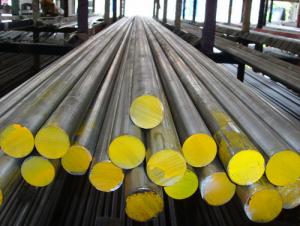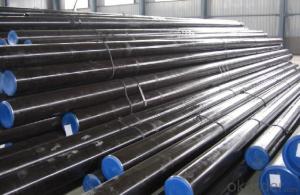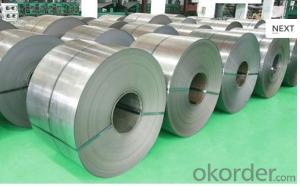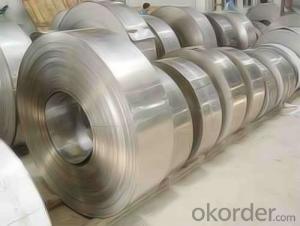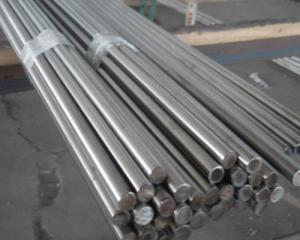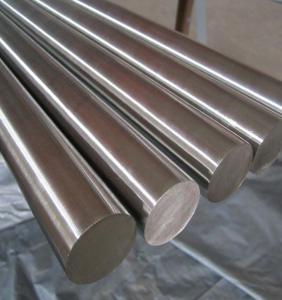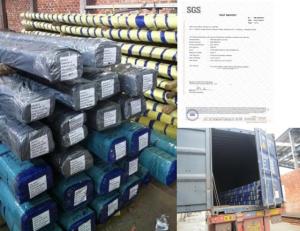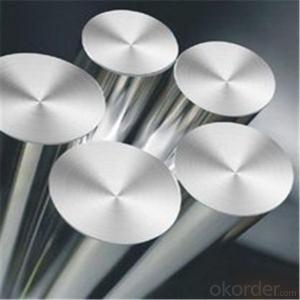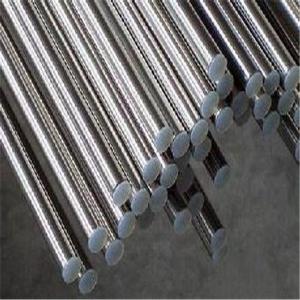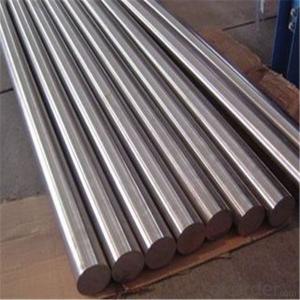Stainless Steel Round Bar Price Per KG in Wuxi,China
- Loading Port:
- Shanghai
- Payment Terms:
- TT OR LC
- Min Order Qty:
- 3 m.t.
- Supply Capability:
- 20000 m.t./month
OKorder Service Pledge
OKorder Financial Service
You Might Also Like
Item specifice
stainless steel bar
Stainless steel is a production which not easy rust,acid resistance and corrosion resistance,so it is widely
used in light industry,heavy industry,daily necessities and the decoration industry.my company long-term
supply stainless steel porducts including:stainless steel sheet,stainless steel coil and stainless steel tube
stainless steel bar chemical composition
C≤0.03 Si≤1.00 Mn≤2.00 P≤0.035 S≤0.03 Ni:12.0-15.0 Cr:16.0-18.0 Mo:2.0-3.0
Mechanical properties of stainless steel bar
Tensile strength (Mpa) 620 MIN
yield strength (Mpa) 310 MIN
elongation (%) 30 MIN
area reduction (%) 40 MIN
density of 8.03 g/cm3,
chromium content (%) 16 - 18
| Product details | |
| Name | stainless steel round bar price per kg |
| Standard | JIS,AISI,ASTM,GB,DIN,EN |
| Dimc | 5-500mm |
| Length | 1-6m or as your request |
| Grade | 200 Series & 300 Series & 400 Series |
| Place of Origin | Henan,China (Mainland) |
| Brand Name | Jianhui |
| Model Number | 420, etc. |
| Shape | Round(we also have Square/Flat/Channel ) |
| Certification | ISO,BV,SGS,CE |
| Special Use | Valve Steels |
| surface | Bright(cold drawn,smooth turned),Black (Hot rolled, hot forged), Polish,or as your need. |
| Craft | Hot rolled,cold draw,hrap |
| Application | These products are widely used in all kinds of architecture and engineering structure, such as the beam, Bridges, transmission tower, hoisting, ship, industrial furnace, container frame and warehouse and Other fields |
| Payment & Shipping Terms | |
| Price | FOB USD 500-4500/ Ton(Get Latest Price) |
| Minimum Order Quantity: | 1 Ton/Tons |
| Port | Shanghai China (or other main port in China) |
| Packaging Details: | Standard export packing or according to customer' s request |
| Delivery Time: | 7 working days after receipt the deposit |
| Payment Terms: | L/C,T/T |
| Supply Ability: | 500 Ton/Tons per Month |
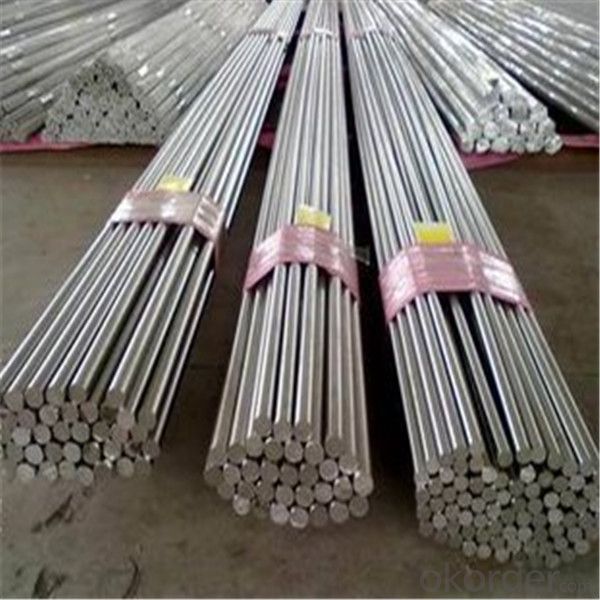

- Q:Is there any difference between 303CU stainless steel bars and 303F stainless steel bars?
- The whole roll has been returned without once. Over the past five years, Wang has ordered about more than 500 tons of steel strips from their company, and only one of them is now available to wang. They also have stories about cooperation with other companies, so you can go and have a look.
- Q:Are stainless steel bars resistant to staining?
- Indeed, staining is not an issue for stainless steel bars. This is due to the presence of chromium in stainless steel, which creates a protective layer on the surface, preventing the formation of rust and stains. As a result, stainless steel bars exhibit remarkable resistance against staining caused by water, chemicals, and other corrosive substances. Moreover, the sleek and impermeable surface of stainless steel bars facilitates effortless cleaning and upkeep, ensuring that their resistance to staining remains intact.
- Q:What about the weight of stainless steel bars?
- For example, the outer diameter of 20mm steel bar, the unit length of 1 meters, weight is 0.02*0.02*3.14/4*1*1000=2.5kg.
- Q:Can stainless steel bars be used in hygienic applications?
- Hygienic applications can indeed employ stainless steel bars. Stainless steel, renowned for its resistance to corrosion and durability, proves to be an ideal material in environments where cleanliness and hygiene hold utmost importance. Industries like food and beverage, pharmaceutical, and healthcare widely adopt stainless steel due to their stringent adherence to sanitary guidelines. Not only are stainless steel bars effortless to clean and maintain, but they also exhibit resistance against bacterial growth and can endure high temperatures and harsh cleaning agents. Moreover, stainless steel's nonporous nature prevents the absorption of liquids and contaminants, rendering it safe for use in contact with food and other delicate products. With excellent hygiene properties and compliance with rigorous industry standards, stainless steel bars confidently emerge as a suitable choice for hygienic applications.
- Q:How do stainless steel bars compare to carbon steel bars?
- The composition, properties, and applications of stainless steel bars and carbon steel bars are distinctly different. Let's start with their composition. Stainless steel bars are primarily made of iron, with the addition of elements like chromium, nickel, and others. These added elements give stainless steel its unique corrosion-resistant properties, making it highly resistant to rust and stains. Conversely, carbon steel bars are mainly composed of iron and carbon, with small amounts of other elements. The absence of chromium and nickel in carbon steel makes it more susceptible to corrosion and rust compared to stainless steel. Moving on to properties, stainless steel bars offer superior strength and durability compared to carbon steel bars. They have a high tensile strength, enabling them to withstand heavy loads and resist deformation. Moreover, stainless steel bars have excellent heat and temperature resistance, making them ideal for high-temperature applications. On the other hand, carbon steel bars, while strong, generally have lower tensile strength and are more prone to deformation when subjected to heavy loads. Lastly, their applications differ significantly. Stainless steel bars are widely used in industries that require corrosion resistance, such as the production of kitchen utensils, medical equipment, and chemical processing plants. They are also commonly utilized in construction, automotive, and aerospace industries due to their strength and durability. In contrast, carbon steel bars find frequent use in applications that prioritize strength and cost-effectiveness over corrosion resistance. Examples include construction, manufacturing machinery, and infrastructure projects. To summarize, stainless steel bars and carbon steel bars exhibit differences in composition, properties, and applications. Stainless steel bars are renowned for their corrosion resistance, strength, and durability, making them suitable for various industries and applications. On the other hand, carbon steel bars, although less resistant to corrosion, offer strength and cost-effectiveness, making them ideal for applications that prioritize strength over corrosion resistance.
- Q:What are the different types of stainless steel bars used in aerospace applications?
- In aerospace applications, there is a wide range of stainless steel bars available with exceptional properties. These bars are commonly utilized due to their unique characteristics. Firstly, we have the Austenitic Stainless Steel Bars. These bars are well-known for their outstanding corrosion resistance, making them suitable for aerospace applications that involve exposure to harsh environments. Additionally, they possess good strength and ductility, making them ideal for high-reliability components. Next, we have the Martensitic Stainless Steel Bars. These bars offer high strength and hardness, making them suitable for aerospace applications that require components to endure high stress and heavy loads. They are commonly used in the production of landing gear systems, engine components, and structural parts. Moving on, we have the Precipitation-Hardening Stainless Steel Bars. These bars provide a unique combination of high strength, corrosion resistance, and toughness. They are often utilized in aerospace applications where components need to maintain their integrity under extreme conditions, such as turbine blades, shafts, and fasteners. Lastly, we have the Duplex Stainless Steel Bars. These bars have a dual-phase microstructure, combining the properties of both austenitic and ferritic stainless steels. They offer high strength, excellent resistance to stress corrosion cracking, and good corrosion resistance. They are commonly used in aerospace applications that require superior strength and resistance to pitting and crevice corrosion, like in marine environments and offshore platforms. In conclusion, the selection of the appropriate stainless steel grade in aerospace applications depends on specific requirements, such as corrosion resistance, strength, hardness, and toughness. By choosing the right stainless steel bar, the components can withstand the demanding conditions encountered in aerospace operations, ensuring safety, reliability, and longevity.
- Q:What is the difference between a solid bar and a hollow bar?
- A solid bar and a hollow bar differ primarily in their internal structure. A solid bar is a cylindrical shape made of a single solid material throughout its entire length. It has a consistent density and provides strength and stability due to its uninterrupted, dense structure. On the other hand, a hollow bar resembles a tube, with empty space in the center. It is made of an outer shell and an inner void. The outer shell provides the necessary strength and rigidity, while the hollow interior reduces the weight of the bar without compromising its overall structural integrity. The choice between a solid bar and a hollow bar depends on the specific requirements of the application. Solid bars are often preferred when maximum strength and durability are necessary, as they are less prone to bending or buckling under heavy loads. They are commonly used in structural applications, such as construction, engineering, and manufacturing. Hollow bars, on the other hand, offer advantages in terms of weight reduction, cost-effectiveness, and flexibility. The empty space allows for various applications, such as passing fluids or wires through the center, making them suitable for industries like plumbing, electrical engineering, and automotive. In summary, the main difference between a solid bar and a hollow bar lies in their internal structure. Solid bars are made of a single solid material throughout, providing strength and stability. Hollow bars, on the other hand, have an outer shell with an empty interior, reducing weight and offering versatility in applications. The choice between the two depends on the specific needs of the project or industry.
- Q:What are the different types of stainless steel bar profiles?
- There are several different types of stainless steel bar profiles, including round bars, square bars, hexagonal bars, flat bars, and angle bars.
- Q:What is the cost difference between stainless steel bars and other materials?
- The cost difference between stainless steel bars and other materials can vary depending on factors such as the specific type of material, grade of stainless steel, and market conditions. Generally, stainless steel bars tend to be more expensive than other materials due to their durability, corrosion resistance, and aesthetic appeal. However, it is advisable to consult with suppliers or conduct market research to obtain specific and up-to-date pricing information.
- Q:What is the price range for stainless steel bars?
- The cost of stainless steel bars may differ based on a multitude of factors, including the grade of stainless steel utilized, the dimensions and configuration of the bars, and the quantity being procured. Typically, the price range for stainless steel bars extends from approximately $1 to $10 per pound. Elevated prices may be expected for superior grades, larger dimensions, and unique shapes. It is advisable to reach out to stainless steel suppliers or refer to online marketplaces for up-to-date pricing details due to potential fluctuations.
1. Manufacturer Overview |
|
|---|---|
| Location | |
| Year Established | |
| Annual Output Value | |
| Main Markets | |
| Company Certifications | |
2. Manufacturer Certificates |
|
|---|---|
| a) Certification Name | |
| Range | |
| Reference | |
| Validity Period | |
3. Manufacturer Capability |
|
|---|---|
| a)Trade Capacity | |
| Nearest Port | |
| Export Percentage | |
| No.of Employees in Trade Department | |
| Language Spoken: | |
| b)Factory Information | |
| Factory Size: | |
| No. of Production Lines | |
| Contract Manufacturing | |
| Product Price Range | |
Send your message to us
Stainless Steel Round Bar Price Per KG in Wuxi,China
- Loading Port:
- Shanghai
- Payment Terms:
- TT OR LC
- Min Order Qty:
- 3 m.t.
- Supply Capability:
- 20000 m.t./month
OKorder Service Pledge
OKorder Financial Service
Similar products
New products
Hot products
Hot Searches
Related keywords




